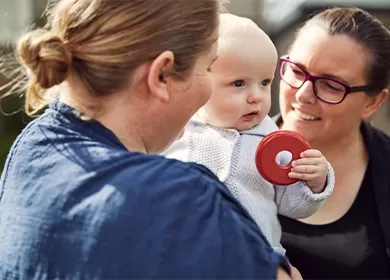Don’t have an account?
Select the donation type you’d like to make
Middle children encouraged to step into the spotlight and save lives this National Middle Child Day
For generations, middle children have lived in the shadows - overlooked, underappreciated, and often forgotten. But this National Middle Child Day, Australian Red Cross Lifeblood is giving them a chance to be the hero their families didn’t see coming.
As demand for blood and plasma hits record levels, Lifeblood is flipping the script on sibling stereotypes with a cheeky call to arms (literally) for middle children across the country to roll up their sleeves and donate blood or plasma - and finally claim the title of favourite child.
“Middle children have always had to fight for attention,” said Lifeblood spokesperson Hannah Rayment.
“This Middle Child Day, we thought, why not give them a chance to be the family MVP by saving lives? It’s a win for them, and a win for patients in need.”
In a recent poll, Lifeblood asked active blood and plasma donors where they fit in the family. Just 26% of the respondents were middle children, compared to 41% who were the eldest and 33% the youngest.
Eldest child donors lived up to the stereotype of being the high achievers in the family, telling us they were often the only donor among their siblings (40 per cent), compared to youngest-sibling donors (33 per cent), and middle children (27 per cent).
With birth-order theory suggesting that middle children are more honest, humble, and agreeable compared to their siblings[1], this the perfect time to prove that nice kids don’t finish last and see middle kids shrug their underdog status.
“We estimate there are a million middle kids[2] out there who have been stereotyped as the underdog, simply because of their birth order. We also know they will try anything to be noticed, prove their siblings wrong, and make their parents proud,” said Hannah.
“What better way to one-up their siblings and get the recognition they deserve than by donating blood and saving up to three lives.”
Australia currently has more than half a million blood and plasma donors, but each year, Lifeblood needs about 100,000 new donors to find their reason to donate and help patients.
While one in three Australians will need blood or blood products in their lifetime, only 1 in 30 donates.
One donation is needed every 18 seconds in Australia, including for people living with cancer and anaemia, patients undergoing surgery, new mothers, trauma patients, and people living with immune deficiencies.
“Right now, we’re really looking for those unsung heroes to come forward and roll up their sleeves when we need it most,” Hannah said.
“While middle children might be overshadowed in their family tree, they’re also resilient, independent, and ready to prove themselves.
“It’s time to put those people-pleasing tendencies to much better use and become life-saving legends.”
You can check out how middle children are becoming the family favourite here.
To book a donation, call 13 14 95, visit lifeblood.com.au or download the Lifeblood App
[1] Ashton, M. & Lee, K. (2024). Personality differences between birth order categories and across sibship sizes Psychological and Cognitive Sciences, Vol 122, No 1. https://doi.org/10.1073/pnas.2416709121
[2] ABS Data, 2021




